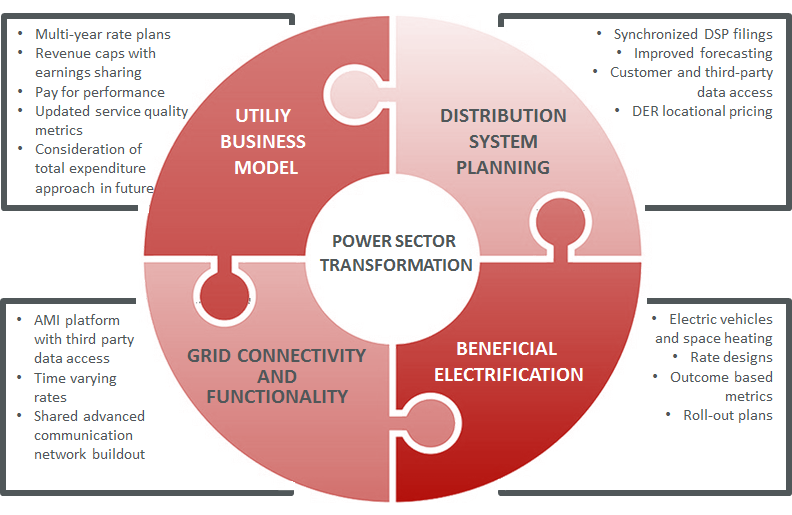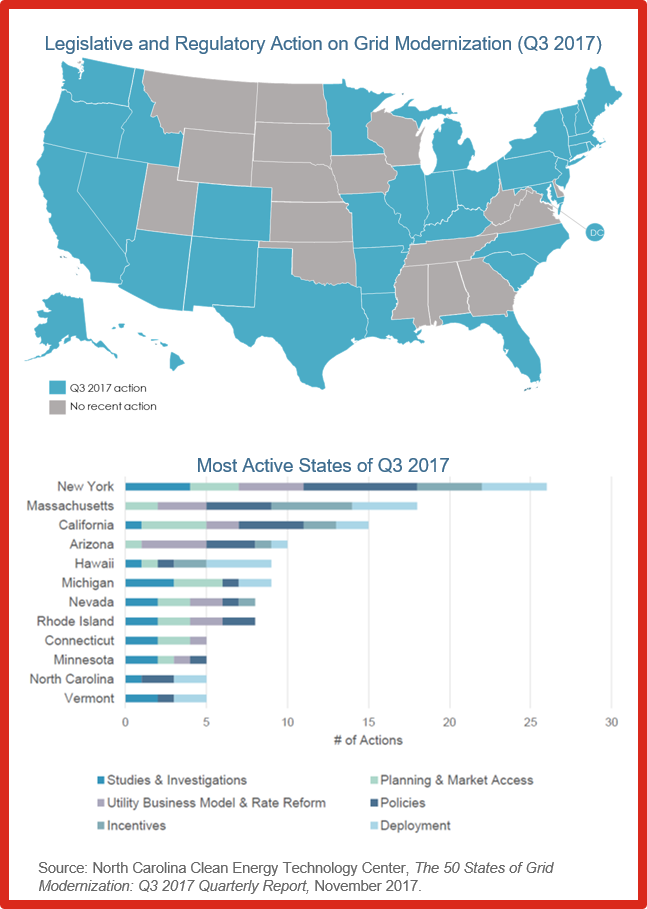On November 8th, Rhode Island’s three energy regulatory agencies – the Public Utilities Commission, the Department of Public Utilities and Carriers, and the Office of Energy Resources – jointly submitted a report to the Governor containing a set of recommendations[1], offering a roadmap for power sector transformation.

Rhode Island Power Sector Transformation
The recommendations are a culmination of a 7-month stakeholder process that was organized into 4 connected work streams – Utility Business Model, Distribution System Planning (DSP), Grid Connectivity and Functionality, and Beneficial Electrification – collectively referred to as the “Power Sector Transformation Initiative.”[2]
The initiative was jointly led by the three energy regulatory agencies in the state at the direction of Governor Gina Raimondo. According to a public letter dated March 2, 2017, the goal of the initiative was to define a new electric regulatory framework for Rhode Island that would:
“…ensure that [its] energy system continues to evolve in a manner that benefits all Rhode Island residents and businesses; fosters job growth and innovation; leverages emerging clean energy technologies to reduce system-wide costs; and enables a more flexible, lower-carbon grid.”
The vision of Rhode Island’s regulators is to shift the paradigm from utility-funded infrastructure projects to one of increased customer and third-party investment in the electric grid.
“…in the past, the utility would use DSP to identify system needs and implement infrastructure solutions. In the future, the utility will use DSP to reveal value opportunities on the system and source DER solutions from the marketplace, and implement infrastructure projects where third-party providers cannot meet system needs.”
Rhode Island seeks to achieve this vision through:
- Business model reform, required to address infrastructure bias and risk of technology obsolescence present in traditional rate making, provide incentives for cost savings, and establish new service quality metrics;
- Distribution system planning evolution, including synchronizing it’s two DSP processes[3], improving peak load forecasting with DERs, increasing system and customer data access, and evaluating distribution locational pricing for DERs;
- Advanced grid connectivity, enabled by AMI platform deployment, time varying rates, and new partnerships and shared investment strategies that will drive expanded data connectivity and functionality beyond traditional areas of utility operations; and
- Beneficial electrification, including the deployment of electric vehicles and the electrification of heating systems, which will serve as a new utility revenue source and play a critical role in meeting Rhode Island’s climate goals.[4]
The transformation envisioned is toward an information-driven utility that will, "...control long term costs, increase customer choice, and enhance the flexibility needed to incorporate more clean energy resources." Instrumental to Rhode Island’s vision is the opportunity for the utility to create new partnerships and new sources of revenue that will allow for innovation and investment beyond traditional ratepayer revenue. Cybersecurity and data privacy are also key areas of focus throughout the recommendations to the Governor.
Rhode Island achieved broad support for its recommendations largely due to an effective and open stakeholder process, which provided the opportunity for input from a diverse set of stakeholders.
The recommendations provided yesterday set the roadmap, but many implementation details remain to be worked out. Continued stakeholder input will be encouraged through the upcoming docketed proceedings.
Grid Modernization Landscape
Across the country, state-led initiatives and customer-driven distributed energy resource adoption is propelling a bigger conversation about modernizing the electric grid. As levels of renewable generation, energy storage, demand response, and energy efficiency increase, “the system” – meaning the physical, regulatory, and business frameworks that provide electricity - becomes more complex. Careful planning and strategic alignment are critical elements of success.
This roadmap firmly positions Rhode Island among the most active states in grid modernization, in the company of New York, Massachusetts, California, Arizona, Hawaii, Michigan, Nevada, Connecticut, Minnesota, North Carolina, and Vermont. And these 12 states are not alone. The NC Clean Energy Technology Center catalogued 184 state grid modernization actions in Q3 2017 that occurred across 33 states plus DC, which is up from 181 and 148 actions catalogued in Q2 and Q1, respectively.

Want to learn more? Let’s continue the conversation.
[1] The Public Utilities Commission, through its staff, participated in the exploratory phase of the Power Sector Transformation initiative, but refrained from discussions of actual implementation pathways and decisions to avoid even the appearance of having pre-judged an issue that may come before them in a regulatory proceeding. For this reason, the recommendations, though jointly submitted to the Governor, are solely the recommendations of the Division and OER.
[2] The Power Sector Transformation Initiative was informed by previous thought leadership through the Energy Efficiency and Resource Management Council, the Distributed Generation Board, the Systems Integration Rhode Island Working Group, the Commission’s Docket 4600, and National Grid as noted in the Rhode Island Power Sector Transformation, Phase One Report to Governor Gina M. Raimondo, November 2017, page 12.
[3] In Rhode Island there are two distinct and separately docketed planning and investment processes: Infrastructure, Safety and Reliability Plan (ISR) – covering the cost of infrastructure projects; and The System Reliability Procurement Plan (SRP) – covering cost of non-wires alternatives (NWA).
[4] Rhode Island’s Electric Vehicle deployment goals, including: The Rhode Island Zero Emission Vehicle Plan goal of 43,000 electric vehicles by 2025, and The Executive Climate Change Coordinating Council (EC4) greenhouse gas emissions reduction scenario targeting the electrification of 34% of on-road vehicle miles traveled by 2035 and 76% by 2050 as noted in the Rhode Island Power Sector Transformation, Phase One Report to Governor Gina M. Raimondo, November 2017, page 58.
